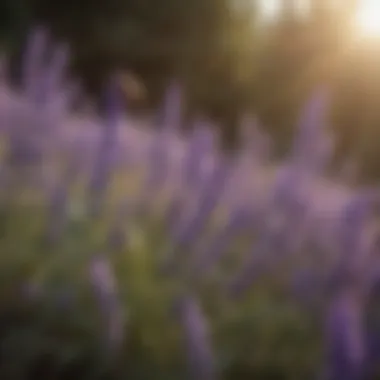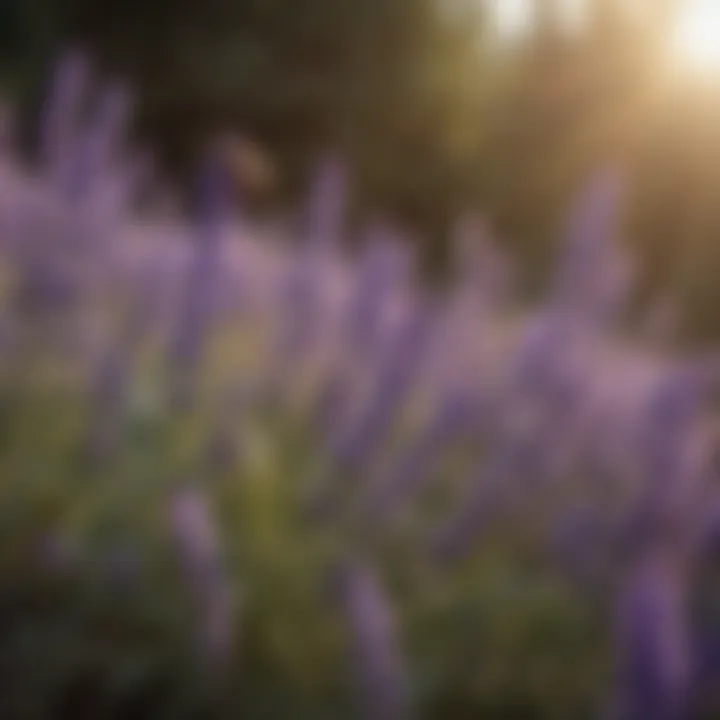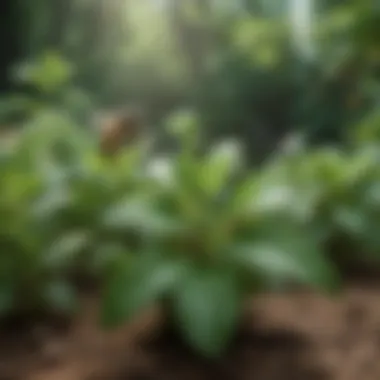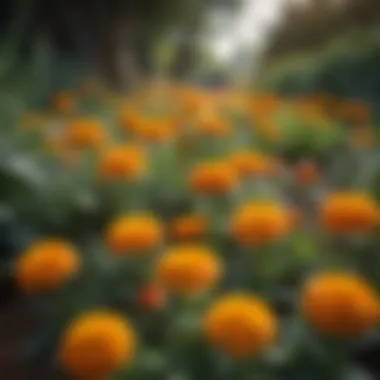Natural Plants to Keep Wasps Away Effectively


Intro
Dealing with wasps can be quite the challenge, especially if you want your garden to be inviting rather than a battleground. Many homeowners find themselves stuck between wanting a beautiful outdoor space and trying to keep these stinging pests at bay. Luckily, nature possesses its own arsenal of solutions. By understanding how to leverage certain plant species, you can create an environment that's less appealing to wasps. This article dives deep into the world of plants that naturally repulse these bothersome insects, providing insights on effective pest management strategies that are both eco-friendly and practical.
Understanding the Pest
Identification
Wasps can often be mistaken for bees, but they have distinct features. For starters, they are typically slimmer and more elongated with a shiny exterior. Their colors can range from yellow and black to even metallic blue in some cases. Notably, the common wasp, known scientifically as Vespula vulgaris, is often spotted buzzing around outdoor picnics, while hornets, like the European hornet (Vespa crabro), tend to occupy more enclosed spaces. Understanding these identifiers can help you distinguish wasps from other beneficial insects, leading to more targeted control methods.
Life Cycle
The life cycle of a wasp unfolds through several stages: egg, larva, pupa, and adult. A queen wasp begins this process in the spring, laying eggs in a nest she constructs herself. These eggs hatch into larvae, which the queen feeds until they mature into adults. This cycle typically peaks during late summer, leading to increased wasp activity. By understanding this pattern, one can anticipate when to use certain plants and strategies to dissuade their presence, creating a more hospitable environment for people and pets alike.
Pest Prevention Strategies
Environment Modification
Incorporating specific plants known to repel wasps is a prime strategy for establishing a less wasp-friendly garden. Some effective plants include:
- Mint: The strong scent of mint is often disliked by wasps and can help deter them from foraging nearby.
- Wormwood: Not only does this plant have medicinal properties, but its pungent aroma also sends wasps packing.
- Eucalyptus: The oil derived from eucalyptus has been known to create a barrier against many insect pests.
Positioning these plants around entertaining areas can create a natural shield against wasps. Furthermore, ensuring a well-maintained garden that avoids attracting them—such as keeping compost piles covered or removing fallen fruits—can significantly lessen their appeal.
Physical Barriers
Creating physical barriers is another approach to shielding your garden. Use fine mesh nets or screens around outdoor dining spaces. This allows you to enjoy a meal without the dread of uninvited wasp guests. Additionally, setting up fake wasp nests can be surprisingly effective; wasps are territorial and often shy away if they sense another colony is nearby.
Control Methods
Chemical Control
While striving for eco-friendly methods is commendable, there are moments when chemical controls might be necessary. When selecting products, especially sprays, opt for those specifically formulated to minimize harm to beneficial insects. Checking the labels and looking for organic or less toxic options can reduce your environmental impact.
Biological Control
Utilizing natural predators can also assist in keeping wasp populations in check. Birds, like the English sparrow, are noted to feast on wasps. Introducing birdhouses can encourage these feathered friends to take residence in your garden, aiding in a more balanced ecosystem. Enhancing biodiversity not only deters wasps but can also contribute positively to the overall health of your garden.
"Creating a diverse and thriving ecosystem in your garden can be the best defense against wasps. The more types of plants and creatures you attract, the fewer pests you’ll have."
Understanding the Wasp Phenomenon
When we delve into the wasp phenomenon, it becomes clear that understanding their behavior and ecological role can significantly affect how we approach pest control. Wasps, despite their sometimes negative reputation, play crucial roles in our gardens and ecosystems. Understanding them can help in developing natural deterrents, especially for householders who prefer eco-friendly methods over pesticides.
Types of Wasps and Their Behavior
There are numerous species of wasps, each with its own unique characteristics and behaviors. Common types that might buzz around your garden include social wasps like the yellow jacket and the paper wasp, and solitary types like the mud dauber. Whereas social wasps can form large colonies, solitary wasps tend to be more discreet, often building individual nests.
- Yellow jackets are notorious for their aggressive behavior, especially around food. They are often confused with bees due to their yellow and black stripes but are easily distinguishable by their more elongated bodies.
- Paper wasps usually create open, umbrella-shaped nests and are often less aggressive than yellow jackets, though they can still defend their territory fiercely.
- Mud daubers, as their name implies, make nests using mud and are generally non-aggressive, unlike their social counterparts.
Understanding these categories of wasps can help you identify which ones are common in your area and how their presence can potentially affect your outdoor activities.
Why Repelling Wasps Is Important
Repelling wasps is not just a matter of comfort; it serves various practical purposes. Wasps can pose threats to both people and pets, especially for those who are allergic. Keeping them at bay minimizes the risk of stings, which can cause severe reactions. Moreover, wasps often invade spaces where food is present, which can lead to discomfort during outdoor gatherings.
By employing plants that deter wasps, you not only enhance your garden's beauty but also create a more serene environment for family and friends. The benefits of using natural pest control methods come in two folds:


- Environmental Safety: Using plants to repel wasps reduces the reliance on chemically manufactured pesticides, which might harm beneficial insects or contaminate the soil.
- Cost-effectiveness: Many wasp-repelling plants like mint or marigolds require little maintenance and can serve multiple roles—like culinary herbs or ornamental flowers—adding value to your garden space.
Ecological Role of Plants in Pest Management
In addressing wasp management, it’s essential to recognize the profound ecological role that plants play. Utilizing plants as part of a broader pest control strategy not only promotes an effective defense against wasps but also emphasizes a more sustainable approach to gardening. Integrating specific flora into the environment leads to a reduction in wasp populations while fostering a balanced ecosystem. This method reduces reliance on chemical pesticides, which can adversely affect the environment.
Plants can act as natural deterrents due to their scent, chemicals, or physical traits. For instance, certain herbs, when grown in proximity to other plants, can mask the scents that attract wasps. Moreover, these plants can attract beneficial insects that help control wasp populations indirectly. Understanding this relationship between flora and fauna is pivotal in creating a thriving garden that supports both human interests and ecological integrity.
The Interplay Between Flora and Fauna
The relationship between plants and insects is essentially a dance – a dynamic interaction that is both delicate and significant. Plants serve not just as shelters, but also as food sources for various creatures. When it comes to wasps, the story becomes even more intriguing.
Wasps are drawn to certain scents and food resources, with their behavior influenced by the types of surrounding plants. If you plant
- Citrusy herbs, such as lemongrass or citronella, they emit a fragrance that can deter wasps from invading your space.
- A variety of flowering plants, like marigolds, offer alternative food sources for beneficial insects that prey on wasps or compete with them.
This interplay signifies that thoughtfully chosen plants do not merely coexist in a garden but actively interact to promote an equilibrium. Thus, enhancing plant biodiversity within one's garden enhances resilience against wasps.
Biodiversity as a Natural Repellent
Biodiversity serves as a natural ally when it comes to wasp control. When a garden boasts a variety of plant species, it creates an environment rich in life, supporting a myriad of pollinators and predators that can help to manage pest populations, including those pesky wasps.
An increase in plant diversity:
- Attracts Natural Predators: These include birds and insects that hunt wasps, thus offering an organic method of control without the need for synthetic pesticides.
- Encourages Healthy Ecosystems: A diverse plant community encourages a vibrant ecosystem with fewer pests.
"A healthy garden should be a habitat, not just a collection of plants."
Giving consideration to plant selection is crucial. It’s not just about selecting the right wasp-repelling species; it’s about creating a well-rounded ecosystem. Bringing in plants from different family backgrounds can enhance resilience to various pests and diseases.
In the quest for a harmonious outdoor space, where garden and home life coexist peacefully, understanding and implementing the ecological role of plants in pest management emerges as a key strategy in effective, natural wasp control.
Plants Known to Deter Wasps
Understanding which plants can effectively repel wasps is paramount for those aiming to create a serene garden environment. Wasps, while playing their own roles in the ecosystem, can become a nuisance when invading spaces where people gather. Utilizing specific types of plants not only serves to alleviate this problem but also enhances the overall aesthetics and biodiversity of a garden. These plants release certain odors or compounds that wasps find unappealing, and thus, they tend to steer clear of lush spaces brimming with these natural deterrents. Furthermore, incorporating such plants encourages a healthy ecological balance, as diverse plant life attracts beneficial insects and discourages pests.
Herbs That Act as Natural Repellents
Mint Varieties
Mint varieties like spearmint and peppermint are particularly effective in warding off wasps, primarily due to their potent aroma. The key characteristic of mint is its strong, fresh scent, which can overwhelm and disorient wasps. Mint is a beneficial choice because it can be grown both in pots for easy placement or directly in the garden. One unique feature of mint is its rapid growth; once planted, it can spread quickly if not contained. While its vigor can be an advantage, it also presents a disadvantage, as it may choke other plants if not managed properly.
Thyme
Thyme offers both culinary and pest-repelling benefits, making it a two-for-one treat for any gardener. Its key characteristic lies in the aromatic oils that emanate from its leaves; these oils are unbearable for many pests, including wasps. Thyme is a valuable addition as it is a low-maintenance plant that thrives in well-drained soil. An advantage of thyme is its ability to bloom beautifully, attracting pollinators while keeping wasps at bay. However, its disadvantage could be its relatively shorter lifespan compared to other herbs, requiring periodic replanting for continuous benefit.
Rosemary
Rosemary is not just a flavorful herb for cooking, but it also serves as a strong natural deterrent against wasps. The prominent feature of rosemary is its woody structure and distinct fragrance, which can effectively mask other scents that attract pests. It's a popular choice in gardens because of its perennial nature; once planted, it can last for years with minimal care. The unique characteristic of rosemary is its resilience to drought, making it suitable for various climates. However, one might consider that its disadvantage is its slower growth rate initially, which may require patience before it fully establishes its pest-repelling prowess.
Flowering Plants to Consider
Marigolds
Marigolds are known for their vibrant colors and pest-repelling properties. Their distinct characteristic is the ability to exude a scent that deters not only wasps but other garden nuisances as well. This trait makes marigolds a beneficial plant for anyone looking to enhance garden beauty while protecting their space. A unique feature of marigolds is their role in attracting pollinators, offering dual benefits for garden health. An advantage lies in their prolific blooming, providing continuous color through the growing season. Yet, their disadvantage might be their susceptibility to certain pests themselves, which can sometimes undermine their protective role.
Geraniums
Geraniums are another flowering option that boasts pest-repelling properties. The key characteristic of geraniums is their aromatic leaves, which can be unpleasant to wasps. They are a beneficial choice as they come in various colors and can complement any garden design. A unique feature of geraniums is their resilience in varied weather conditions, making them easier to grow. However, a significant disadvantage is that geraniums may require periodic deadheading to encourage blooming, which involves added maintenance.


Citronella
Citronella is renowned for its insect-repellent qualities. The specific aspect of this plant is its essential oils, which are highly effective against various pests, including wasps. Citronella not only serves as a popular choice for gardens but lends itself well to creating a soothing outdoor ambiance with its fresh scent. A unique feature of citronella is its ability to thrive in container gardens, making it versatile for small spaces. However, its disadvantage includes the need for warm weather; it may not survive harsh winters, demanding proper seasonal care.
Other Notable Species
Ragweed
Ragweed is often overlooked in discussions of pest control. Its essential quality is the ability to deter wasps, primarily due to its unique scent that many pests find off-putting. This makes ragweed a beneficial option for attracting beneficial insects while repelling unwanted visitors. A unique characteristic about ragweed is its adaptability to various soil types, helping it grow in more diverse environments. However, a notable disadvantage is its notorious allergenic properties, which may not be suitable for people with sensitivities.
Goldenrod
Goldenrod is not only beautiful but also serves a practical purpose in pest management. Its key distinguishing feature is its late bloom, providing an essential food source for pollinators while also attracting beneficial insects that prey on wasps. This quality renders it a valuable addition to a biodiverse garden. A unique trait of goldenrod is its hardiness, allowing it to flourish in various conditions. Yet, it is worth noting that one disadvantage could be its spreading nature, which may require careful management to prevent overcrowding in the garden.
Buttonbush
Buttonbush is a lesser-known plant but holds significant merit in natural pest control strategies. Its specific aspect lies in its flowers that attract pollinators while simultaneously repelling wasps. This dual action makes buttonbush a beneficial choice for fostering a thriving garden ecosystem. A unique feature of buttonbush is its tolerability of wetland areas, making it adaptable to diverse soil conditions. Conversely, an advantage is its distinctive appearance, adding ornamental value to any outdoor space; however, its disadvantage includes potentially needing more room to grow, so it's essential to consider space constraints when planting.
Growth Requirements for Effective Wasp-Repelling Plants
When it comes to cultivating plants that deter wasps, understanding their growth requirements is crucial. These plants don't merely rely on their natural defenses; they also require favorable conditions to thrive and exude the properties that keep these pesky insects at bay. Knowing about soil composition, sunlight needs, and watering techniques can make or break your efforts in creating a wasp-resistant garden. This section will delve into these aspects, providing a comprehensive guide to ensure your plants grow healthy while effectively repelling unwanted visitors.
Soil and Nutrient Needs
The foundation of any healthy plant is undoubtedly the soil in which it grows. For wasp-repelling plants, the right soil mix isn't just about pH levels; it's about creating a nutrient-rich environment. Herbs like mint and rosemary thrive in well-drained, loamy soil, while flowering plants like marigolds prefer slightly sandy conditions that allow for good drainage. Here are a few points to consider:
- Well-drained Soil Composition: Ensure that the soil does not retain excess water. This is critical. Heavy, clayey soils may suffocate roots and invite root rot, negatively affecting plant health and their ability to repel wasps.
- Nutrient-Rich Additives: Incorporating compost can add vital nutrients, enhancing the robustness of your plants. It encourages strong growth and improves the aromatic qualities that help repel wasps.
- Regular Soil Testing: Every garden is unique. Testing the soil can reveal its nutrient profile, allowing you to tailor amendments that boost plant health for better determent of wasps.
Optimal Sunlight Exposure
Just like humans need the sun for energy, so do plants. Different species have varying sunlight needs, and knowing these can significantly affect their growth and effectiveness in keeping wasps at bay. Plants such as citronella and geraniums usually prefer full sun, requiring at least six hours of direct sunlight each day. To optimize sunlight exposure, consider these factors:
- Location Matters: Position your garden in areas where it will receive ample sunlight, preferably away from tall trees or structures that may cast shade.
- Rotate Plants Regularly: If possible, rotate plants each season to maximize sunlight exposure. Some plants may thrive better in full sun, while others might enjoy partial shade, and rotating can optimize conditions overall.
- Monitor Sunlight Patterns: Watch how sunlight hits your garden throughout the day. This understanding will help you place plants according to their specific requirements, resulting in healthier plants.
Watering and Maintenance Guidelines
Water is life. However, knowing how much and how often to water is essential. Overwatering can lead to mold and mildew, detrimental to plants like mint and thyme, which prefer slightly drier conditions. Here are some practical tips for watering and maintenance:
- Watering Schedule: A routine schedule is beneficial. Early mornings or late evenings are the best times to water, minimizing evaporation and allowing plants to absorb moisture efficiently.
- Mulching Benefits: Adding a layer of mulch around plants can help retain soil moisture while suppressing weeds that could compete for nutrients.
- Watch for Signs: Pay attention to your plants. Yellowing leaves may signal overwatering, while droopy leaves can indicate underwatering. Adjust accordingly.
"The secret to a thriving garden often lies not just in the selection of plants but in the understanding of their needs."
In summary, mastering the growth requirements for effective wasp-repelling plants is paramount for ensuring a less invasive outdoor experience. By focusing on soil quality, sunlight exposure, and diligent watering practices, you pave the way for healthier plants that contribute to a wasp-resistant environment.
Strategic Planting for Maximum Effectiveness
When it comes to keeping wasps at bay, strategic planting holds significant weight in any pest control plan. This isn’t merely about plopping down a few herbs here and there and calling it a day. The art lies in how, where, and why you choose to plant specific species. Thoughtful placement can make a realm of difference, not just in aesthetics but in functionality.
Placement in Gardens
Selecting the right location for your wasp-repelling plants can mean the difference between an inviting outdoor oasis and a hotbed for these pesky insects. Ideally, you want to plant these allies near areas where you spend most time, such as patios or swimming pools.
- Proximity to Entrances: Think about where you sit outside. Do you have a favorite nook? Placing plants like mint or basil close to chairs can act as a first line of defense.
- Group Planting: Instead of scattering plants throughout your garden, it’s beneficial to group them. By creating a small cluster, the cumulative aroma can intensify, forming a fragrant barrier.
- Use of Borders: Consider making a border with plants known to repel wasps. Lavender, for instance, not only provides fragrance and beauty but can also deter these insects when grown in a compact row.
"Surrounding your seating areas with the right plants not only beautifies your space but creates a natural shield against unwanted visitors."
Companion Planting Techniques
Companion planting is another robust strategy that significantly enhances the effectiveness of your wasp-deterring garden. This technique is about more than mere aesthetics; it's a savvy and sustainable approach to pest management. Different plants can have a synergistic relationship, where one supports the other’s characteristics.


- Mixing Aromatic and Flowering Plants: For instance, planting marigolds alongside herbs like thyme offers double protection. While thyme has aromatic properties enjoyed by chefs and disliked by wasps, marigolds emit a smell that can ward off a variety of pests.
- Native Plants as Allies: Incorporating native plants not only contributes to biodiversity but they’re also better adapted to local conditions. They may attract beneficial insects, like ladybugs or lacewings, which feast on pests that could otherwise provide food for wasps.
- Symbiotic Relationships: Certain plants, such as coriander and dill, can act as repositories for beneficial insects that prey on wasps. When these plants flourish in your garden, they help create a balanced ecosystem, promoting harmony rather than confrontation.
Using companion planting isn’t just a one-size-fits-all approach. Understanding the individual needs and characteristics of both the repelling plants and their companions leads to increased efficacy in wasp deterrent strategies. A little thought can go a long way toward creating a peaceful outdoor retreat.
Complementary Pest Management Strategies
In the modern world, where pest control often leans heavily on chemical solutions, a shift towards natural alternatives becomes increasingly relevant. Complementary strategies that work alongside the use of plants not only bolster our defenses against wasps but also preserve the integrity of our ecosystems. This approach emphasizes a symbiotic relationship between different elements of a garden, promoting a balanced environment that curtails pest populations effectively.
Natural Predators of Wasps
Utilizing natural predators is one of the most effective complementary pest management strategies for dealing with wasps. Introducing beneficial insects into your garden can help keep wasp populations in check, creating a delicate balance in nature. For instance, birds such as the purple martin have been known to feast on wasps and their larvae, making them a valuable ally in pest control.
Additionally, parasitic wasps—different from the annoying predators you aim to manage—lay their eggs inside the larvae of larger wasps. This dampens the growth of wasp populations significantly. Encouraging these predators can often be as simple as planting flowers that attract them, such as yarrow or dill, enriching both your garden and pest management efforts.
"A garden thriving with natural predators can often combat pests more effectively than chemical solutions in the long run."
Habitat Management and Modification
Making subtle changes to your garden’s habitat can significantly influence the prevalence of wasps. First, reducing clutter in areas where they might build nests is crucial. Keeping spaces tidy—removing old wood piles, dead branches, or any potential nesting locations—hinders wasps from establishing a foothold.
Furthermore, water sources play a significant role in pest attraction. Stagnant water is an open invitation for pest infestations. Ensure that any standing water is cleared periodically. Additionally, consider maintaining diversity in your garden flora. A variety of plant species can help attract beneficial insects while deter wasps.
In summary, by combining the use of specifically chosen plants with the strategic encouragement of their natural predators, as well as careful habitat management, homeowners can create a resilient ecosystem. This not only helps in keeping the wasps at bay but also fosters a thriving garden that can flourish with life. By taking a holistic view of pest management, we honor and utilize the natural cycles occurring in our environments.
Challenges and Limitations
When we talk about using plants to keep wasps at bay, it’s crucial to consider the challenges and limitations inherent in this method. While integrating natural pest control techniques is not only beneficial for the environment but also a smart approach to manage unwanted pests, it does have its share of hurdles that must be weighed.
Seasonal Variability in Wasp Populations
One of the most significant challenges is the seasonal variability in wasp populations. Wasps are not consistent in their presence throughout the year. As the seasons change, so does their behavior and abundance. In spring and summer, when their colonies are thriving, you might find them buzzing around more frequently, while they become less active as temperatures drop in fall and winter.
Because their activity spikes during certain months, relying on plants alone may not provide a foolproof method of protection. The effectiveness of certain plants will likewise ebb and flow along with the wasp activity. For instance, using peppermint or citronella can be more effective in warmer months when wasps are more aggressive. After all, plants take time to mature and establish a presence in a garden.
"Understanding when wasps are most active can help you strategize your gardening and pest control efforts."
This variability poses a challenge to gardeners looking for a reliable defense against wasps. Homeowners need to be proactive and aware of their local wasp species and when they're likely to be most troublesome. Therefore, combining plant strategies with other pest control measures may enhance effectiveness and offer more comprehensive protection.
Plant Effectiveness: A Variable Factor
Another aspect to consider is that not all plants work equally for every environment. Factors such as soil quality, climate, and placement can significantly influence the effectiveness of wasp-repelling plants. It can sometimes feel like trying to hit a moving target, so to speak.
For example, a species like marigold may thrive in a sunny garden in one location but fail miserably in a shaded backyard. Here, the garden's microclimate plays a vital role, affecting how well certain plants can produce the compounds that deter wasps. Furthermore, the size and health of the plants also matter; weak or struggling plants are less likely to yield that desired protective effect.
Additionally, individual gardening practices and maintenance levels will greatly affect outcomes. A well-tended succulent garden can deter wasps while a poorly maintained plot may actually attract them. This brings up the importance of considering not only which plants to include but how to nurture them properly.
Thus, while plants can serve as a formidable ally in pest management, homeowners need to remember that effectiveness can be inconsistent. Keeping these variables in mind and adapting one’s approach can lead to a more harmonious coexistence with nature and a garden that’s both beautiful and less prone to pesky wasp visitors.
Final Thoughts on Using Plants Against Wasps
When considering the use of plants as a strategic method to deter wasps, one must acknowledge not only their ecological benefits but also the potential empowerment of local communities. Engaging with nature through these plants is more than just about repelling a pest; it's about creating a dynamic interaction with our environment. Each garden can become a sanctuary for diverse flora and fauna, ultimately reducing the overall pest presence, including wasps. This proactive approach fosters an appreciation for biodiversity, which can lead to more sustainable practices and a healthier ecosystem.
The Role of Community in Pest Management
In pest management, the importance of community cannot be overstated. It involves pooling resources, knowledge, and experiences to tackle common issues. Consider how a neighborhood could collectively adopt wasp-repelling plants like mint and rosemary. When individuals share their successes, tips, and even failures, it contributes to a collective learning experience.
- Community Gardening: By coming together to create community gardens, homeowners can experiment with different plants tailored to deter wasps. A shared space not only beautifies the area but enhances the educational aspect as you see what works best in your specific environment.
- Local Workshops: Communities can organize workshops on pest management. This fosters a knowledge-sharing ecosystem and helps residents learn how to cultivate these plants effectively.
- Social Media Engagement: Platforms like Facebook and Reddit provide a great venue to discuss experiences and garner advice on specific flora. Sharing photos and tips within community groups can bolster an understanding of what the best practices in wasp deterrence are.
Emphasizing Continuous Learning and Adaptation
When it comes to using plants against wasps, continuous learning is key. The environment is not static; changes in climate, seasons, and even plant health can affect their effectiveness in repelling pests.
- Observational Learning: Homeowners should closely observe which plants thrive in their locales. Not all plants will have the same impact in every garden. For instance, while some might find goldenrod beneficial, others may notice a decrease in wasp activity with lemongrass. The trick is monitoring and adapting.
- Researching New Strategies: Staying informed through reliable sources such as Wikipedia or Britannica about newly discovered pest control plants expands your gardening knowledge. New studies often unveil plants that might be even more effective.
- Trial and Error: Don't shy away from experimenting. Whether that means introducing new herbs into your garden or creating mixed plant beds, trial will teach home gardeners what works best for them and their environment.
In closing, the journey toward natural pest control using plants is a continuous adventure that encourages community action and constant evaluation of methods. By inadvertently tying together ecological and social strategies, we can create environments that are both pleasant and functional. A healthy garden is one that embraces both plants and knowledge, fostering a community that thrives alongside nature.







